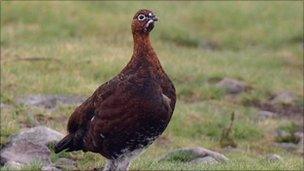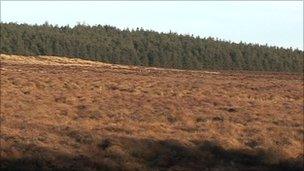Rare red grouse 'saved from extinction' in Glenwherry
- Published

Red grouse numbers had declined sharply due to predator attacks
The red grouse, one of Northern Ireland's rarest game birds, has been saved from dying out in a remote upland area of County Antrim.
Down to just six pairs, a grouse regeneration project at the Department of Agriculture's Glenwherry farm has involved culling hundreds of foxes and crows, as well as regenerating the heather grazing.
Grouse shooting is a lucrative business in Scotland where a single day on the moor can cost hundreds of pounds, but while the Scottish economy is raking in millions, in Northern Ireland grouse numbers have been in decline.
The moor at Glenwherry in the hills above Ballyclare was once well stocked with grouse.
But habitat decline and predation by foxes and crows meant that young grouse had little chance of surviving.
By the time a grouse regeneration plan was launched three years ago, the population was down to just half a dozen pairs.
The first thing that had to be done was to reduce the number of enemies the grouse had to contend with.
That turned out to a bigger job than anyone had thought.
The upland farm is bounded by a number of conifer plantations and it was from here that the foxes were launching their attacks.
In a little over three years the head game-keeper shot 300 foxes.
Crows and magpies, too, pose a threat to grouse nests and so hundreds of these predators have also been killed.
The next stage of the regeneration project involved improving the food supply for the young grouse.
That has been done by managing the heather habitat.
Right from the start, young grouse rely on fresh green sprigs of heather.

The project is taking place in Glenwherry
But old heather which is overgrown is no use as the young birds simply can't reach up to the juicy part of the plant.
Heather burning is the answer. But it's not simply a case of setting the moor alight.
The young birds still need older heather bushes to nest and hide in.
And as the cover must not be too far away from from where the birds graze, the burning programme needs to be carefully planned.
The idea is to produce a mosaic of heather plants at different stages of regeneration.
Give grouse the right habitat and numbers can recover quite quickly - a typical clutch of eggs can range from three right up to 15.
Providing the weather in early summer isn't too wet, the young grouse only have to contend with predators and intestinal worms.
Medicated grit is left out for the birds to peck.
The grit helps the grouse grind up the heather shoots in their gizzards while the medication helps them deal with the worms
Grazing with livestock is also important to keep the moorland habitat from becoming overgrown with grass.
It is still too early to say if the moor will ultimately sustain a commercial shoot, but the early signs are encouraging for the grouse population.